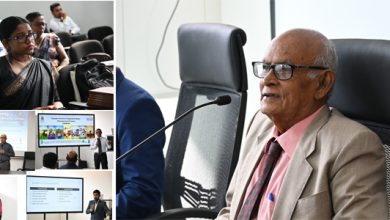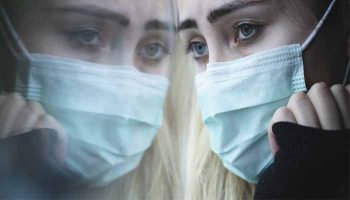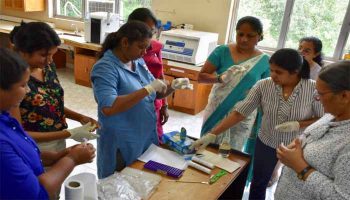Masks enrich Sri Lanka’s ritualistic heritage
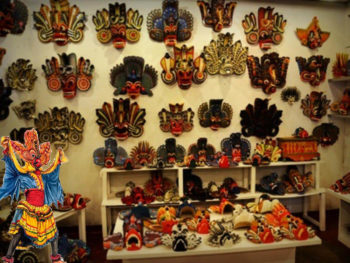
The hereditary traditional masks of Sri Lanka can be classified into a number of groups such as Kolam, Sanni, Pali and Raksha and each one of these has a legend connected to it. Although clear evidence as to when and where (the art of) masks originated is scarce, historical evidence clearly go to prove that they existed in the coastal areas of the low country community for over two centuries. While mask carving and dancing have spread in the South Western coastal areas, Ambalangoda, Mirissa and Pokunuwita have become renowned for this.
The origin of the art of masks has occurred concurrently with that of the Kolam dance. According to folk lore the birth of Kolam dance, which is one of the main items of mask dances, has been created relating to a pregnancy craving. When a woman conceives, some of them crave for sour food like mangoes, and tamarind while others like to eat sea fish, fresh water fish etc… Thus during the days of king Maha Sammatha, his wife became pregnant and she got a pregnancy craving to see dances accompanied, with jokes and humour.
As there was no one who knew about dances accompanied with humour at that time, the pregnancy craving of the queen got aggravated and the king and the whole royal assembly had to face an arduous and embarrassing situation. The king took immediate action by summoning the royal tom – tom beater and ordered him to go round the country and announce that if there was anyone who could fulfill the craving of the Queen he should venture or come forward immediately. As this too was in vain, the king was very much worried and was in a great melancholy mood. At this juncture, God Sakra, the incumbent of the two heavens seeing this sorrow summoned Vishwakarma the Lord for dance and creation in the heaven , and instructed him to take appropriate action.
Accordingly, God Vishmakarma placed masks and books containing the way of singing the songs in the royal garden. On the following day, the royal gardener came across these wooden masks and the book containing the texts. Coming to hear about this, the king was highly delighted and summoned some citizens and ordered them to perform the dances. This not only fulfilled the pregnancy craving of the queen, but marked the origin or birth of a new form of dance called Kolam and the folk art of masks.
- Creation of Masks/ Mask Making / Carving
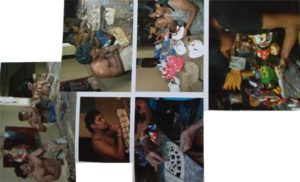
In the olden days the wood of the tree ‘Din’ which grew in the banks of rivers, had been used to carve masks. As this was not durable or long-lasting, wood of the VelKaduru or Rukattana was used. More often than not, VelKaduru is used in the carving of low country traditional masks. This tree which grows mostly in marshy lands can be seen abundantly in the proximity to paddy fields. Our ancestors had realized through experience that the wood of Kaduru was most suitable as it was light, convenient to carve and easy to dance while wearing. The wood of Kaduru was not used for any household purposes, not even as firewood because it was believed that the pots and pans may burst and crack.
Before carving masks, the ancient craftsmen performed a number of rites connected with that. Before falling down the Kaduru tree they would look for an auspicious time, offer flowers and lamps to the incumbent deity of that particular Kaduru tree and plead him to move to some other tree. It was only after this that they started cutting down the tree.
As the trunk of the Kaduru tree is covered with a thick milky bark, the first thing they do is to remove it. After the log of wood dries up in the gentle breeze it is cut into the necessary and appropriate size. In carving a mask from the separated log, our ancestors, following the traditional and hereditary carving verses, highlighted the features of the mask. There are carving verses for most of the masks. This is a verse recited when carving a Surambavalli Mask.
- SingithiMuvamudunē
- DëleMakarudedenē
- Emëdanārivarunē
- Kiyanmëseti Surambavarunē
- A tiny cute face on top
- two makaras (Dragons) on either side
- In the centre of them a lady
- Shall describe thus the features of Suramba
A mask carving verse of the mask of King MahaSammatha
- Usin pas viyathMahaSammathaMuhunē
- Devurathunviyaththunagulamenagannē
- Thiringithaleketayamkirulisaennē
- Sirasepipununelumakiketayamwannē
- The face of MahaSammatha is five spans in height
- The shoulders are three spans – measure three inches
- Two sides of the head are decorated with a scroll work or creeper design
- Fully blossomed lotus is carved on the head.
A carving verse (embunkavi) of the GuruluRaksha mask
- Mudunasëdiotunū
- Sirasanaipenathunakinū
- Gësuhandaakunū
- ĒyaGurulek me sädilakunu
- Crowns on top
- Three cobra hoods on the head
- With the sound of thunder (Thunder bolt)
- Comes a Gurula with these features.
According to the above Ämbum Kavi special measuring tools have been used to get the appropriate dimensions, namely measuring by eyesight, measuring with fingers, by cubit or 18 inches length etc. Akshi Manaka or measuring by eyesight means observing with the eyes and preparing the measures. Anguli Manaka means measuring by using the fingers.
Except in the Kolam Masks, the shapes of the masks of King, Queen and Rakshas have to be prepared first. For this purpose a dummy is made out of cardboard or a thick kind of paper. Separate dummies are prepared for the nose, lips, eyes, auricles etc. For them the following tools are used.
- Cross cut saw (wide in the centre)
- Cross cut saw
- Hand saw
- Vice
- Mallet
- Gouge and flat chisels varying from2, 1, ½, and ¼ cm
- A pair of compasses
- Small hand saw
Figure 05 – Tools used in the carving of masks.
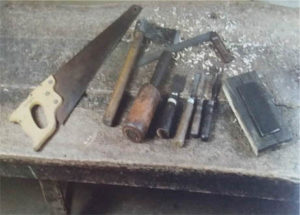
The completion of a mask from a piece of prepared log can be classified into five (05) steps
- Cutting into blocks or chunks
- DalaGaseema -preliminary shaping
- Bara Gaseema– Highlighting of features like nose, eyes etc.
- Cleaning
- Whitening and applying colours
Dalagäseema means the preliminary shaping of the log of wood cut out using the cross cut saw and the hand saw. Later baragäseema starts with the normal highlighting of the features like the eyes, lips, nose etc.
This partly completed mask which is humid is kept above the hearth and allowed to be fumigated or smoked for about a week. The features and postures of the face of the mask taken out of the fire place are further highlighted by using chisels of various sizes. The mask is put near the fire place twice and at the next stage all the features are completed and this in transformed in to a complete mask.
Because of the smoking, the humidity in the wood disappears and at the same time the insects in the wood are destroyed. Furthermore, no new insects will creep into the wood because of the smoking. The ancestors have followed this method to preserve the wood for a longer time. Because of this, a traditional mask can be preserved safely for even a number of centuries. The masks of King MahaSammatha, the Queen and other masks found at the Ambalangoda Mask Museum are over 200 years old and are golden examples of this.
The next step before applying colours to the masks is to smoothen it. For this the ancestors have used the skin of sea fishes Maduva and the beak of Talapath and Del Savaran, the tender leaves of bread fruit trees. At present abrasive material like sand paper is used.
In applying colours to the masks barks of trees, flowers and kinds of stones all of which are obtained from the natural environment, are mixed with Dorana Oil and the colours are prepared.
- Red – Sadalingam Gurugal (kind of stones)
- White – Makulu- earth
- Purple –flowers of Bovitiyā & Ranawarā
- Yellow – Hirigal (Hirigal – Limestone) and Sivanguru – red clay
- Black–Charcoal of Coconut – shells
- Green – Leaves of Ladappa, Madatiya and Margosa Trees.
The brushes used in colouring the masks are made of the roots of the screw pine tree (Vatakeyya) and fur of animals. It takes a long time to paint a mask when following traditional methods. The reason for this is that when colours prepared by mixing Dorana Oil inn is applied, it takes three to four days to dry. Until it dries up well no other colour can be applied on it. Accordingly, to complete a mask in the traditional way, it takes a minimum of three weeks.
In the same way, when creating Kolam Sanni and Pali Masks, the ancestors had used the fur of animals and the fibre of trees. For teeth in some of the Sanni and Pali Masks, the teeth and bones of animals, tusks of pigs or boar and the fur of cocks had been used. Thus when analysing these masks, it is evident that the ancestors had used only local raw materials.
Traditional masks created like this have been used for various purposes from the past. Out of these some masks, have been indispensable for folk dances like the Kolam Maduwa, rituals like the eighteen Sanni, Devol Maduwa, Gara Maduwa and Riddi Yaga as well as for processions and home decorations.
Kolam Dances
Kolam dances can be mainly described as a form of indigenous or local folk dance. In folk usage it is known as the ‘Kolam Maduwa’.In addition to evoking humour and laugher it depicts the Sinhala society in the colonial era. The immoral behavior of the king’s officials, both high and low are exposed and ridiculed. This Kolam dance which evolves round the arrival of the king and the queen includes a number of various characters.
The arena where the kolam dances are performed is called the “Thanayampola” (Figure – 07).This is a circular ground decorated with the inner trunk of banana trees, tender coconut leaves, colocasia leaves, arecanut flowers, coconut flowers, clay lamps, torches made of cloth big and small and flower beds.
 Figure – 07 Thanayampola
Figure – 07 Thanayampola
- Vesattha
- Mal Yahana – flower bed
- KariyakarawanaRala- narrator
- Drummers
- Trumpeter
- Chorus or group of singers
- Dressing room
- Arena
- Lamp bed
- Audience
From both sides of the vesattha where branches of Goraka or Gamboge are planted and decorated with arecanut leaves, the Kolam dancers enter the arena gesticulating.
After the lighting of lamps and worshipping the Buddha and the recital of verses of phrase or the doxology, the Kolam Maduwa starts amidst the thundering sounds of the beating of ceremonial drums and blowing of conch shells. The Yak Beraya (Low Country drum), the trumpet and the cymbal are the main musical instruments used.
There is a special character called the Kariyakarawana Rala, who by his conversations with the characters in the Kolam Maduwa highlights the proceedings for the audience ). While he conducts the entire Kolam Maduwa he does not wear a mask. After the Kariyakarawana Rala and the chorus recite the poems or verses of the birth of Kolam, the various characters wearing masks enter the dancing arena.
The first to enter the stage is the Anabera Kolama. The following are the verses of the book sung before the AnaberaKolama enters the stage.
- Athata sera yatiyai
- Urayata davul berayai
- Thadamahaluwayasai
- Warengurunērājapanathai
- A walking stick in the hand
- A drum on the shoulder
- Very much aged
- Come the teacher to announce the king’s orders
- Athapayavevullā
- Hisa kata nikataullā
- Davul uraellā
- Eyasabayata guru mahallā
- With the hands and feet shivering
- The head and chin pointed
- With a drum hanging from the shoulder
- The old teacher comes to the assembly
After the reciting of these verses the Anabera Kolamaor “Panikkala” accompanied by a group of children enters the stage rhythmically according to the drum beat. Drunk after taking a lot of liquor, he falls down, on the stage vomiting.
In the meantime the Kariyakarawana Rala inquires from the children as to what has happened and informs the audience. Later he summons Nonchi Akka, the Mother of the children and engages in a conversation with her.
- Nonchikaravarune – Punchiwayasathpasuvemine
- Nonchimāvisine – Nonchiakkāentaenne.
- Exaggerating herself – the teacher, with the young age passing
- Nonchi Akka is on the way.
- Nivasanethadanne – savasagedarinennē
- WayasapasuwenneNonchiakkasabeenne
- Does not know the house – comes from the house in the evening
- The age passes or diminishes – Nonchi Akka comes to the assembly.
The dialogues among the children, Nonchi Akka and Panikkala causes much laughter in the audience and at the same time depicts the shortcomings in their characters and the social stress they are faced with. At the end Panikkala informs the audience with a drum beat about the arrival of king MahaSammatha and the Queen to the arena and leaves with his children after performing a dance to a Suddha Māthra drum beat.
AnaberaKolama
NonchiAkka-
NonchiAkka and a child
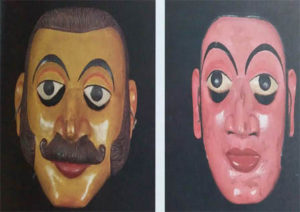 After this,Vidana Arachchi and Liyanappu enter the arena or the dancing area. Their duty is to count and write down the number of people who have come to see the King and Queen in the Royal assembly. The dialogues in this item are full of humour. Liyanappu who is the clerk of Arachchi is heavily drunk and takes down the number of males and females. He even counts the unborn babies in the mothers’ wombs.
After this,Vidana Arachchi and Liyanappu enter the arena or the dancing area. Their duty is to count and write down the number of people who have come to see the King and Queen in the Royal assembly. The dialogues in this item are full of humour. Liyanappu who is the clerk of Arachchi is heavily drunk and takes down the number of males and females. He even counts the unborn babies in the mothers’ wombs.
After the Arachchi Kolama the Polis Kolama enters the assembly . The Kolam artist has added this Kolama to humiliate the harassment the people had to undergo from the Policemen during the British colonial regime.
Ekolanthurenā
- Nobindapilivelamethanā
- Wāsalamurehisitinā
- Eyakostāpaldedenathosinā
- Out of these Kolam
- Not distorting the order here
- Engaged in guarding the palace
- The two constables come happily
- Kaluendumendagena
- Baton pollaklāgena
- Basthamasurathagena
- Kostapalvaruēyavigasina
- Wearing black clothes
- With a baton fixed (to the cloth)
- Taking the walking stick in the right hand
- The constables come swiftly
Police Kolama
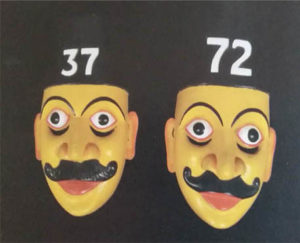
ChandiSorundhaminimarunwandhabebaddandaumathudhana
- Val tharunanda, gunamakuwandasudukarundha rata nasana
- Balapāmindhagenabandimindhaneethilesindhamānchudanā
- Lokumahathandhapatisājandhakosthapalundhabalanumenā
- Thugs, robbers, criminals, drunkards, lunatics
- Uncivilized people, ungrateful people, gamblers who ruin the country
- Using force and tying them and hand cuffing them lawfully
- Please look at the chief officer, the sergeant and constables.
It is after this that the HewaKolama enters the assembly. Four soldiers, representing the soldiers during the time of the Sinhalese kings come to the assembly. The following is a verse regarding the entering of the soldiers.
- Nirindugenporana – sitinathanathurulebagena
- Nominabadajalayana – goluda, mukkanthunaknamwana
- Anēyuda kala seti – Kanēnasēlēketi
- Alekatavetiveti – anehewaralaenahati
- Obtaining posts & designations from the ancient kings
- Three by names of glutton, dumb and broken nose
- Oh! the way they fought the war clots of blood in the ear and nose
- Oh! the way the soldier comes falling again and again to a side
Hewa Kolama
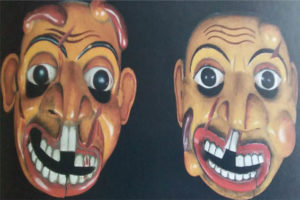
These dancers enter the arena with a unique tune to check the security of the assembly before the king’s arrival.The Kariyakarawana Rala, noticing the wounds due to sword cuts and the leeches hanging on to the faces of the soldiers, inquires about it. They explain that the wounds are the result of holding their faces instead of the shield at the war of Gampola. As they could not bear up the pain, they had immersed their faces in the Kandy Lake and there the Saneepa Kurullan (Leeches) clung to their faces. Later, demonstrating dramatically how they fought the war of Gampola, they leave the Thanayam Pola or the assembly bringing it alive with some interesting and hilarious dialogues.
Verses of the departure of soldiers.
- Allāpeenesnāsenseravagalamina
- Sollapāde kora kotaandabimaena
- Illāraminsunvethadabarakaraminā
- Kollahewabadajalanataiudapenā
- Holding the nose with mucus trickling due to catarrh
- Shaking the lame leg and thumping it hard on the ground
- Quarrelling with people demanding toddy
- The soldier Badajala dances jumping up
- Perasitapevathaena – Sirithatapodhiyabendagena
- Urapitathabāgena – YōdhaJasayāēyaduwagena
- As coming from the past – tying the bundle (of clothes)
- Keeping it on the shoulder- the giant Jasayā comes running
While the audience hears this verse, Jasaya, accompanied by his nephew Sebaranchi enters the dancing area. They start hanging canopies, laying carpets and surrounding the road with screens where the king and queen will travel.
To hasten this task he brings his wife too .The Mudali or the village chief (Figure 18 – Page 35) who passes this place with Henchappu (Figure – 17 – Page 35) sees the beautiful Lenchina and is enchanted with love and begins a conversation with her, ignoring the duty for which he came. Lenchina too, courting the Mudali describes the shortcomings of her husband in front of him thus arousing laughter in the assembly. These acts clearly demonstrate how the Mudali who performs a very important and honourable duty in the government gets humiliated by himself by engaging in a deplorable behavior like this.
Figure 15 – Sebaranchi with Jasaya
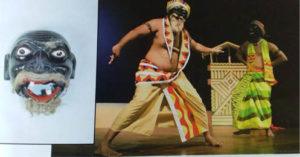
- Man vagepedikathakmanā-Dutuwadalovērusirendina
- Mawpiyonidahasvennata -mawadunnainakivuhamekuta
- A cute washer women like me – have you seen a more beautiful women in this world
- For the parents to get free – I was given in marriage to acodger with a wrinkled skin
- Undalahatakamburannata – yedainnesuranhata des kotā
- Nakiunathmatakamnethe – mage dosatheninthenapavasathe
- To work to repay their debt – I plead the goods to curse
- I don’t mind him being old – he critises me here and there about my shortcomings.
- Vakutukudhenondipayathiya – E kethatabendapulesa me pambaya
- Yasaruvatakoralahedithalagoya – hatasaranedeelamavpiyogiya
- Hunch backed and lame legged – like a scarecrow tied in a paddy field
- To an iguana with scabies – the parents gave me in marriage and went away
- Mage himiyapambayatathiyan – hora himiyogennagannameman
- Keeping my husband as a scarecrow – I get down illegallovers
- Eta depotakdenavayikiya – māvaravatagiyearatharunayā
- Nivasataevitharatharunaya – Redhigannaevitharkavataya
- Promising to give me two garlands of beads – That youth cheated me and went away
- That youth having come to the house – That joker having come to sell cloths
Lenchina
Henchappu
Mudali

As the royal servants like the drummer, Arachchi, soldiers, washerman and Mudali have completed their duties, the arrival of the Royal couple, accompanied by the cabinet of ministers takes place. While the Kariyakarawana Rala comes in front carrying a lighted torch, king MahaSammatha and the Queen come to the arena with the help of that light and take their seats to watch the dances.
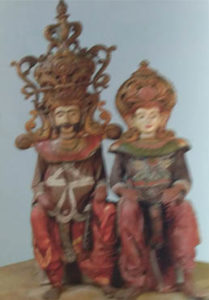 King MahaSammatha& Queen
King MahaSammatha& Queen
Sinha Kolama or the lion dance is the first to be performed in front of the King and Queen. This is followed by the Naga Raksha dance The king cobra has a huge cobra hood on the head and small cobras in the forehead. Even the nostrils consist of small cobras. The eyes of this Raksha are jutting out. The Naga Raksha dance ends with the performance of two beautiful Naga Raksha.
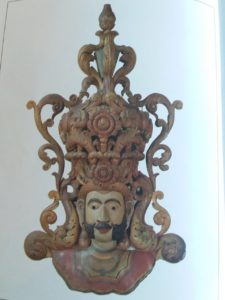
Sinha Kolama –
Naga Raksha-
The next to arrive is the exquisitly carved Gurulu Raksha with a crown and three cobras on the head and one grasped by the beak . He performs a very speedy dance or a fling and keeps the audience dumbfounded. After the dance of the two Gurulu Rakshas, a pregnant woman enters the stage and the Kariyakarawana Rala gets into conversation with her regarding her travail or labour pains. This Kolam, termed as Badadaru Kolama performs a dance blaming the males. The Badadaru Kolama departs after invoking blessings on the pregnant women in the assembly.
- Dethinpandugena
- Ahasatadamaallana
- Me sabathulanatana
- Surambavalliyabalansathosina
- Taking balls in the two hands
- Throwing them into the sky and catching them
- Dancing in this assembly
- Watch happily the SurambaValli
Suramba Valli who enters the assembly with verses like this performs an astonishing delicate dance and a fling like goddesses.
 Further, in addition to Parangi Kolama Karapita Kolama (Figu Kapiri Kolama , stories like Gama Kathawa and Gon Koti Kolama which are full of humour and ridicule are performed in the arena or on the stage.
Further, in addition to Parangi Kolama Karapita Kolama (Figu Kapiri Kolama , stories like Gama Kathawa and Gon Koti Kolama which are full of humour and ridicule are performed in the arena or on the stage.
It is after this that the Jathaka Stories are performed. This is staged as an example to the society. Very often Danuddhara Jathakaya (Maname) Sandakinduru Jathakaya and the tale or story of Gotaimbara are performed on stage.
At the end of the Kolam Maduwa, GaraYaka comes to the stage. The GaraYaka performs to dispel all evil eye, evil mouth, and all other evil and bestow good will blessings to all. The dance he performs swinging on the Vesatta is breathtaking. The Kariyakarawana Rala engages himself with the Gara Yaka in a dialogue of very hilarious manner. All the dances performed till dawn on the following day will come to an end with the dance of the GaraYaka or Gara demon bestowing blessings to all, thus culminating the traditional KolamMaduwa.
4 Sanni Yakuma Ritual
The Sanni Yakuma or the 18 Sanni ritual occupies an important place among the rituals performed wearing masks. The 18 Sanni demons causing diseases, the twelve palis, the main demons and other inhuman beings stated in the legend of Maha Kola have been recreated and thus presented. By this the artist has been able to present a member of beautiful masks.
The Nidhana Kathava or the related past story of Maha Kola Sanni
In the past king Sankapala descending from the lineage of Lichchavi Kings of the city of Vishala married princess Ayupala as his chief queen and was ruling Dambadiva or India, which was full of prosperity and splendour. A neighbourhood country declared war against him, and at that time his chief queen princess Ayupala was pregnant, but king Sankapala was not aware of this. As he had to go to a very distant place and this would take a long time, he entrusted all the work of the queen to the chief lady servant of the palace and went to war. In the meantime the queen developed a pregnancy craving and longed to eat mee-amba or very sweet mangoes. As it was the off season for mangoes the ministers were faced with a difficult task of finding very sweet mangoes.In the end the ministers publicized this message using drum beats in the country and got down two or three mangoes and offered them to Queen Ayupala. When the queen was eating the mangoes with a great liking, a great desire to eat sweet mangoes occurred in the chief lady servant and she asked for some mangoes. As there were no sufficient mangoes,the queen rejected her request and ate the mangoes alone by herself. The servant was greatly annoyed by this and a great feeling of anger occurred in her mind. When the king returned to the palace after achieving victory in the war, the servant who was hoping to take revenge from the queen lied to the king that the queen had a clandestine connection with the royal officers. The king enraged with this news ordered the royal executioners to rip his pregnant queen into two. At the time this innocent queen was taken to the thick forest and ripped into two, she aspired that by the power of my chastity which I guarded as my life may there be no injury or harm to the child in my womb. Although the child in the womb was ripped into two, it got stuck into one because of the aspiration made by the queen and grew up with the help of the animals in the forest. With the wisdom with which this prince could see the past he realized that his father killed his innocent mother and with the idea of taking revenge from him he prepared 18 poisonous balls by grinding the fangs of snakes, vipers and other blood sucking serpents. Later he became known as the Maha Kola Demon (Figure 32).Obtaining permission from king Vesamuni, he went to the city of Visala, the kingdom of his father and made all the citizens there sick by throwing the eighteen balls prepared by him. This is the same incident referred to as the three pronged horror stricken famine of Visala.
The Sanni Yakuma ritual is performed to relieve a person of a disease caused by evil spirits (Sanni demons) but the demon specialist or exorcist does not decide to perform a Sanni Yakuma at once. A relative of the patient meets the exorcist and conveys to him all the details. After that the exorcist prepares and ties a thread for the safety of the patient. If the patient does not recover within three days he prepares another thread to be tied around the neck of the patient. Accordingly he keeps this thread on a small platform containing flowers and betel etc. spells charms on it and ties it around the neck of the patient. After that he pleads the evil spirits who caused peril to the patient, reciting the Ratana Sutra and recollecting about the gods,decides about a date to offer them meat, flesh, roasted meat and sacrifices. The patient’s party should arrange and provide the necessary things for the ritual to be performed.
During day time of the scheduled date, some exorcists will come and prepare some flower beds with sticks, barks of trees, banana trunks, young coconut branches, coconut flowers,arecanut flowers, areca nuts andkitul. Here is a beautiful flower seat for the triple gem and gods. In the centre of the arena is a Sanni YakumVeediya (a place for the Sanni demon to dance). There is another feature called the Sanni Kuduwa or the Sanni cage. Various beautiful flower beds are prepared for various demons. One flower bed is prepared for the deceased relatives and another for prethas. One is assigned for the preparation of sacrifices. All food placed in the flower beds are prepared by him. The necessities of both parties namely the patient and the exorcist are looked after by him.
As the sun sets, the exorcists first wear ”Piruwata” or clean clothes. Then the chief exorcist summons the patient who was prepared earlier, to the arena. Then giving a lighted “Vilakku” or torch to the patient’s hand, makes him light the lamps in the flower altar prepared for the gods worshipping the triple gem, and takes his seat. Then he engages himself in a short dialogue with the members of the patient’s party. Turning to the drummers he becomes talkative with them and charms the holy yellow water. After sprinkling the charmed water to all including the patient he engages himself in a dance inviting the gods Vishnu, Kataragama, Nātha, Saman, Paththini and the gods incumbent to the four directions.
Next the chief exorcist gives offerings to the demons of the SändaSamayama. Here ‘thatu’ or small flower altars are placed for the KaluYaka, ReeriYaka and SuniyamYaka while the arena is beamed with the light of the torches both big and small, (Pandam&Vilakku) and covered with the smoke of burnt resin.The charming of manthras or spells begin amidst the thundering sound of drums. By this the demons who caused illnesses are invited.Meanwhile the demons possessing the patient come to the arena. At this juncture, the exorcist inquires the details and arranges a time to make the offerings. The next dance is the SändaSamayama.Wearing head dresses made with carved young coconut leaves, wrapping red cloths around the waist, and taking two lighted torches (Pandam) in the two hands, a few exorcists dance according to the thundering drum beats.Very often, the patient gets into a trance and jumps into the middle of this dance.
The Five Yakas or demons
As a result of the sins done in the earlier births, the demons get a very low status. They have an abnormal power to frighten people and make them sick by possessing them.
- KaluYaka – Makes small children and women sick. Also clever in evoking erotic dreams connected to sex and love among the young.
- ReeriYaka – Causes diseases related to blood.
- MahaSona – Frightens people and causes fever.
- SuniyamYaka – The most wicked of the five demons. During day time he appears as God Suniyam but causes people sick during the night.
- AbhimanaYaka – Causes mental diseases. Frightens people.
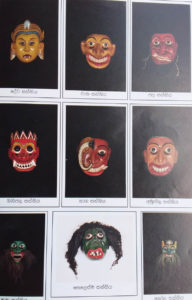
When a Sanni Yakuma ritual in performed with the idea of healing a patient the five chief demons KaluYaka, ReeriYaka, SuniyamYaka, MahaSona and AbhimanaYaka are summoned to the arena. Very often the Abhimana demon does not come. In certaininstances dancers wearing masks too come. To the demons who come like this the chief exorcistsexplains how the actions of that particular demoninfluences the patient and makes the patient give offerings separately and requests them not to cause any trouble again. After the arrival to the arena and offerings are made, the demons should leave the patient.
The next part of the ritual is the Kumara Pelapaliya or the princely group dance. Here the birth of demon Maha Kola is depicted in verses, dance and drumming.In this ritual, the twelve palis come before the arrival of the Sanni demons (Figure – 29). Being followers of king Vesamuni, they come to clean the premises and prepare offerings to the Sanni demons. Each Sanni is invited to accept strainers containing rice of various colours, milk strainers, Sandle wood strainers, oil strainers and roasted corn strainers. In addition food made with blue coloured rice, rice with roasted meat, food made of red coloured rice, food made of paddy from the dry land fields, five coloured rice, milk rice, black coloured rice etc. are prepared separately for the offerings.
- PandamPaliya – Burning torches
- DhunuPaliya – A bow and an arrow
- KendiPaliya – A pot containing water
- DalumuraPaliya – Offerings of betel and flowers
- AnguruDummalaPaliya – Burning charcoal and resin
- KalasPaliya – A pot with coconut flowers
- KukuluPaliya – A cock
- ThembiliPaliya – A king coconut
- MuguruPaliya – A club or cudgel
- SaluPaliya – A shawl
- AthuPaliya – Branches of trees
- KaduPaliya – A sword
Some faces of the 12 Palis
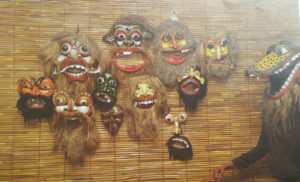
First comes the PandamPaliya illuminating the arena. The main duty of this Pali is to obtain the permission of the deities for the other Palis to come. Next comes the AngruDumamlaPaliyacarrying a vessel containing resin and smoking the place to purity it. This is followed by the KaduPaliya, carrying a sword in the hand and waving it inall directions. By doing this he creates a belief in the patient that all evil in the place iseradicated and blessings are bestowedupon him. Next comes the KalasPaliya keeping a coconut flower in a clay pot to worship the deities.
Thus all the Palis come purifying the arena and providing protection for it. Accordingly each and every Palithat comes, brings the necessary goods for offerings. We clearly understand it with the coming of the KukuluPaliya.KendiPali carrying a pot, SaluPali carrying a shawl, DalumuraPali betel, ThembiliPalia king coconut, AthuPali carrying branches enter the arena. DunuPali carrying a bow and arrow, MuguruPali a cudgel or club, chase away the other demons who obstruct the coming of the Sanni demons. Every Pali that comes like this entertains the audience with hilarious jokes. By this they purify the mind of the patient and bring relief to him. The Sanni demons, seeing that the place in clean and protected and the necessary offerings for then have been provided, come to that place.
After the twelve Palis come and clean the arena and arrange the offerings, the Sanni demons accept the invitation and arrive at the place. Those who come like this are fierce and majestic. They have the power to possess human beings and make this sick.
- Bhutha Sanni – Causes temporary madness.
- Kōla Sanni – He occupies the most important place in the Sanni Yakuma.The exorcist gives offerings for all those who made the patient sick and make them leave him.
- Deva Sanni – Causes measles, mumps, diarrhoea, small pox, typhoid, and cholera
- Golu Sanni – Causes temporary dumbness.
- Bheetha Sanni – Causes temporary unconsciousness by frightening
- Pith Sanni – Causes diseases of the bile
- Pissu Sanni – Causes temporary madness
- Jala Sanni – Causes unbearable cold and shivering
- Amukku Sanni – Causes stomach pain and vomiting
- Kora Sanni – Causes lame limbs and swollen joints
- Gedi Sanni – Causes abscesses in the body
- Kana Sanni – Causes temporary blindness
- Maru Sanni – Causes death
- Vaatha Sanni – Causes sickness caused by air in the body and paralysis
- Naga Sanni – Causes poison similar to snake poison, in the body and blisters and swellings
- Bihiri Sanni – Causes temporary deafness
- Ginijala Sanni – Causes burning sensation in the body and mental pain
- Selesma Sanni – Causes unbearable headache and stress
The demons who caused the patient sick are summoned to the arena by the chief exorcist.With the upper part of the body attired in black and a waist dress made of Burulla leaves, the Sanni demons enter the arena. In most occasions, every Sanni demon comes wearing a mask according to the disease he can cause, and they come in an order. The way the patient was made sick is revealed by the dialogue with the exorcist. After that the demons ask for offerings to cure the patient. After receiving the offerings, the demons agree to cure the patient and the exorcist makes them promise that they would do no harm to the patient thereafter.
The dances of the eighteen Sanni demons are very attractive and the hilarious dialogues are enchanting and enjoyed by all. There are 18 sets of verses recited in front of the patient to dispel the diseases caused by the eighteen Sannis. Given below is one of them recited for the GinijalaSanni.
- Vamatheikiliyegedihataganne
- Papuvata e gediperaleeenne
- Sihiyaknethuvamagosinvetenne
- GinijalSanniyaledadenaganne
- Abscesses are formed in the armpit of the left hand
- Those abscesses roll down to the chest
- Goes and falls unconscious
- Know the diseases of the Ginijala Sanni
- Gunapathanodenee nan dedavillā
- Kana bona de netharujavaallā
- Engayatapodikaramin le sollā
- Ginijalasanniyaeyipudaillā
- Talking nonsense not – knowing what is right or wrong
- Does not eat anything because of aches.
- Crushing the body and bleeding
- Ginijala Sanni comes asking for offerings
- Ekka senagakonthayudaganne
- Isivara den kendagotudekaganne
- Makkamasamanalanapethirenne
- GinijalSanniyaledaherayanne
- Talking the rossary with the retinue
- The saint now takes the two strainers of gruel
- The order of Saman prevails in Makkama
- The Ginijal Sanni departs discarding the diseases
After the arrival of the Sanni demons, their chief,Maha Kola arrives. Although the Kola demon tries to go near the patient, he is debarred by the exorcist. After they promise to leave the place, they are given the prepared offerings. After accepting the offerings Maha Kola demon and the other demons leave the arena bestowing blessings to the patient.
As a result of the coming of the Sanni demons, the place becomes polluted and to clean the place and to repel all ill effects, the double torch dance is performed. After that, limes are cut and blessings bestowed to the patient and other members of the family and chanted amulets are tied to them. Finally all evil effects on the patient and other members are dispelled and blessings bestowed on them, wrapping up the Sanni Yakuma.
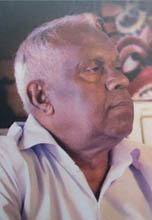 Badrananda Wihesuriya(Owner)
Badrananda Wihesuriya(Owner)
ARIYAPALA AND SONS
426, Main Street, Ambalangoda, Sri Lanka.
[T]: +94 912258373, [F]: +94 912258948
[E-mail]: info@masksariyapalasl.com
http://www.masksariyapalasl.com/mask_museum.htm


